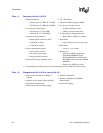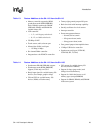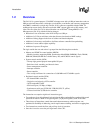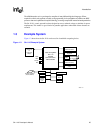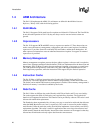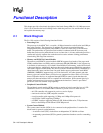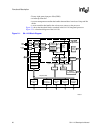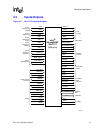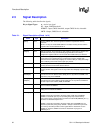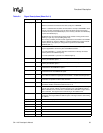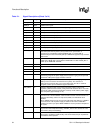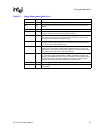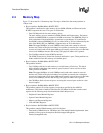
SA-1110 Developer’s Manual 29
Functional Description 2
This chapter provides a functional description of the Intel
®
StrongARM
*
SA-1110 Microprocessor
(SA-1110). It describes the basic building blocks within the processor, lists and describes the pins,
and explains the memory map.
2.1 Block Diagram
The SA-1110 consists of the following functional blocks:
• Processing Core
The processor is the ARM
*
SA-1 core with a 16 Kbyte instruction cache (Icache) and 8 Kbyte
data cache (Dcache). The instruction (I) and data (D) streams are translated through
independent memory-management units (MMUs). Stores are made using a four-line write
buffer. The performance of specialized load routines is enhanced with the four-entry read
buffer that can be used to prefetch data for use at a later time. A 16-entry minicache provides a
smaller and logically separate data cache that can be used to enhance caching performance
when dealing with large data structures.
• Memory and PCMCIA Control Module
The memory and PCMCIA control module (MPCM) supports four banks of fast-page-mode
(FPM), extended-data-out (EDO), and/or synchronous DRAM (SDRAM). It also supports up
to six banks of static memory: all six banks allow ROM or Flash memory, each with non-burst
or burst read timings. Additionally, the lower three static banks support SRAM, the upper three
static banks support variable latency I/O devices (with the variable data latency controlled by a
shared data ready input), and the lower four static banks support synchronous mask ROM
(SMROM). SMROM is supported only on 32-bit data busses. All other dynamic and static
memory types and variable latency I/O devices are supported on either 16-bit or 32-bit data
busses. Expansion devices are supported through PCMCIA control signals that share the
memory bus data and address lines to complete the card interface. Some external glue logic
(buffers and transceivers) is necessary to implement the interface. Control is provided to
permit two card slots with hot-swap capability.
• Peripheral Control Module
The peripheral control module (PCM) contains a number of serial control devices, an LCD
controller as well as a six-channel DMA controller to provide service to these devices:
– An LCD controller with support for passive or active displays
– A universal serial bus (USB) endpoint controller
– A serial controller with supporting 115 Kbps and 4 Mbps IrDA protocols
– A 16550-like UART supporting 230 Kbps
– A CODEC interface supporting Motorola SPI, National Microwire, TI Synchronous
Serial, or the Phillips UCB1100 and UCB1200 protocol
• System Control Module
The system control module (SCM) is also connected to the peripheral bus. It contains five
blocks used for general system functions:
– A real-time clock (RTC) clocked from an independent 32.768 kHz oscillator
– An operating system timer (OST) for general system timer functions as well as a watchdog
mode




